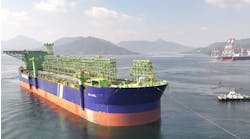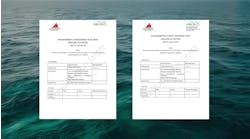Explorationists continue to drill into deeper and hotter environments, challenging the limits of conventional logging tools and techniques. At depths approaching 30,000 ft, and temperatures above 175°C, conventional logging tools lose accuracy and measurement precision. Early solutions included putting conventional logging tools in Dewar flasks and acquiring data as fast as possible to minimize the tool's exposure to temperature, but this often resulted in poor data quality.
In 1996, Schlumberger began developing a suite of logging tools specifically for hostile environments. The goal was to integrate the latest technologies into one high-pressure, high-temperature (HPHT) logging string rated to 260°C and 25,000 psi, with exceptional temperature holding times. The Xtreme Evaluation Services Platform came out of this effort and field tests began in early 1998.
To date, 40 field tests have been conducted worldwide targeting a variety of downhole environments. Schlumberger says consistently successful results have been achieved, including logging the deepest well ever drilled in the Gulf of Mexico. Located in 2,663 ft of water in the Garden Banks area, the well was logged on behalf of EEX Corporation. It was drilled to a depth of 27,864 ft and was logged twice with the system using two different conveyance methods: conventional wireline and drill pipe.
In a test for Coastal Oil and Gas Corporation in South Texas, low speed, high-resolution nuclear data were desired. The logging job was run at speeds as low as 1,000 ft per hour in a well with maximum temperatures of 190°C. Because more than 6,000 ft of section was logged, the string was downhole in operation for more than eight hours.
Another feature of the system was used in another South Texas well. A high-temperature array induction-sonic combination was run in a well with a bottomhole temperature of 221°C.
Technology suite
The Xtreme platform consists of upgraded versions of several existing Schlumberger logging tools combined with a new-generation HPHT array induction tool. For a given well, an appropriate combination of system tools is fashioned into a single toolstring to meet data acquisition needs. The system platform is modular, providing array induction, digital sonic, litho-density, epithermal array porosity, and spectral gamma ray. It includes the following:
- Array Induction tool - This tool is based on the same new-generation technology found in the array induction tool family, but the electronics have been flasked and an induction antenna coil array sonde capable of withstanding hostile conditions has been added. It measures formation resistivities with five different depths of investigation and the operator may choose from three vertical resolutions, to a height of 1 ft. It computes water resistivity and saturation, invaded and fresh zone resistivities, and invasion profile-measurements that help determine reserve estimates and reservoir producibility. Data acquisition can occur at speeds up to 3,600 ft/hour.
- Digital Sonic tool - This is a monopole (nondirectional firing) sonic tool that provides either borehole-compensated or long-spaced formation velocities for computing the mechanical properties of the rock matrix. These properties factor into the design of well completion and production programs. The tool also measures formation porosity and can be used in defining casing, cement and formation bond by measuring the amplitude of a sonic wave traveling through casing.
- Hostile Litho-Density sonde-This is a pad tool that uses two detectors and a Cs-137 directional chemical source to measure formation bulk density and photoelectric factor. The tool uses a conventional spine and rib algorithm to correct for stand-off and hole rugosities.
- Accelerator Porosity sonde - This is an epithermal neutron logging tool that uses a neutron generator, instead of the traditional chemical source, encased in a fully characterized, high-pressure (25 kpsi) Dewar flask. Epithermal high-energy neutron measurements suit the high-temperature environment as they require few temperature corrections. These measurements provide good indications of formation lithology, shaliness, and gas content, which geologists use to define the depositional environment and age of a potential reservoir.
- Hostile Natural Gamma Ray Spectrometry sonde - This sonde measures potassium, thorium, and uranium concentrations and provides borehole corrections for potassium-based and barite-based mud systems. The high-efficiency bismuth germanate gamma ray detectors in this tool are internally flasked and can be precooled with carbon dioxide prior to running in the hole for extended holding time.
- Telemetry Gamma Ray cartridge - This part of the toolstring features the communications electronics, an accelerometer for real-time speed correction and a gamma ray (GR) detector housed in one flask. The GR detector is used to find formation tops and correlate stratigraphy to nearby wells. Associated with the wireline-logging head, the tool provides real-time mud temperature measurements, which are often used to compute thermal gradient.
In total, an Xtreme toolstring is 111 ft long and offers logging speeds of 900, 1,800 ft/hr and 3,600 ft/hr, with 1,800 ft being standard.
It features a thermal management system based on low-power electronics, hostile-rated materials, and an increased thermal mass to slow down internal temperature rise. Several constituent parts contain internal temperature sensors, providing a continuous monitor of internal temperature build-up during a logging job. A series of accessories rated for hostile conditions has been developed in conjunction with the toolstring. This includes:
- Flex joints for highly deviated logging
- Swivel heads for horizontal well logging
- Tool tension-compression adapters
- Tough logging conditions system that uses drillpipe to push the tool string through deviated hole sections and to desired depths
- Double-drum capstan system to reduce cable surface tension when logging wells with depths in excess of 30,000 ft
- An electronic cable release mechanism to release the logging head weak point in the event of tool fishing operations.
Special, high-temperature plastic components along with low-power electronics largely contribute to the toolstring's temperature holding times - more than 12 hr at temperatures in excess of 260°C and pressures greater than 25,000 psi.
Field tests are nearly complete and commercial roll-out of the system should be announced soon. Meanwhile, further tools are being developed to fit this HPHT string. With continued interest in the deepwater Gulf of Mexico, as well as other HPHT regions, the need for hostile-environment logging solutions continues to grow.


